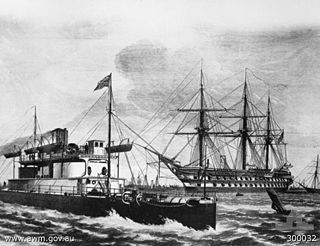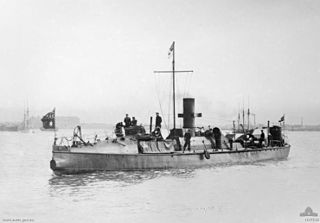
The Royal Australian Navy (RAN) is the principal naval force of Australia, a part of the Australian Defence Force (ADF) along with the Australian Army and Royal Australian Air Force. The Navy is commanded by the Chief of Navy (CN), who is subordinate to the Chief of the Defence Force (CDF) who commands the ADF; the current CN is Vice Admiral Michael Noonan. The CN is also directly responsible to the Minister of Defence, with the Department of Defence administering the ADF and the Navy.

HMQS Gayundah was a flat-iron gunboat operated by the Queensland Maritime Defence Force and later the Royal Australian Navy. She entered service in 1884 and was decommissioned and sold to a civilian company in 1921. She then served as sand and gravel barge in Brisbane until the 1950s, when she was scrapped. In 1958, Gayundah was run aground at Woody Point near Redcliffe, to serve as a breakwater structure.

HMAS Quiberon (G81/D20/D281/F03) was a Q-class destroyer of the Royal Australian Navy (RAN). Although built for the Royal Navy and remaining British property until 1950, Quiberon was one of two Q-class destroyers commissioned into the RAN during World War II. She was passed into full RAN ownership in 1950, and converted into an anti-submarine frigate.

HMPNGS Lakekamu is Balikpapan-class landing craft heavy (LCH) operated by the Maritime Operations Element of the Papua New Guinea Defence Force (PNGDF). The vessel was one of eight built for the Royal Australian Navy (RAN) in the 1970s, and was commissioned into the RAN as HMAS Labuan in March 1973. Labuan was decommissioned in November 2014. She was transferred to the PNGDF for use as a training ship and was commissioned as HMPNGS Lakekamu in December 2014.

Before Federation in 1901 five of the six separate colonies maintained their own naval forces for defence. The colonial navies were supported by the ships of the Royal Navy's Australian Station which was established in 1859. The separate colonies maintained control over their respective navies until 1 March 1901, when the Commonwealth Naval Forces was created.

HMQS Paluma was a flat-iron gunboat operated by the Queensland Maritime Defence Force and later the Royal Australian Navy. She entered service on 28 October 1884, was decommissioned in 1916 and then sold to the Victorian Ports and Harbours Department, who operated her under the name Rip until 1948 when she was retired. She was scrapped in 1950–51.

HMQS Mosquito was a torpedo boat operated by the Queensland Maritime Defence Force and Commonwealth Naval Forces. She entered service in 1885 and after Federation was transferred to the Commonwealth Naval Forces, serving as a training vessel until she was paid off in 1910.

After the formation of the Queensland Maritime Defence Force in 1884, the colonial government purchased two gunboats and a torpedo boat to equip the new force. However, given the number of ports along the Queensland coast it was realised that additional ships were required. Five ships had already been ordered for the Queensland Department of Harbours and Rivers when the decision was taken to convert them to also serve as auxiliary gunboats. This resulted in the fitting of a 5-inch gun and the relocation of the boilers below the waterline. The ships were as follows: Bonito, Bream, Dolphin, Pumba, and Stingaree.

HMAS Diamantina (K377/F377/A266/GOR266), named after the Diamantina River in Queensland, is a River-class frigate that served the Royal Australian Navy (RAN). Constructed in the mid-1940s, Diamantina was active from 1945 until 1946, was placed in reserve, then was recommissioned as a survey ship from 1959 until 1980.
Twelve ships of the Royal Navy have borne the name HMS Mosquito, or the archaic HMS Musquito, after the tropical insect, the Mosquito:

HMS Cormorant was an Osprey-class sloop launched at Chatham on 12 September 1877 and later the receiving ship at Gibraltar. She was renamed Rooke in 1946 and broken up in 1949.

HMQS Otter was launched in 1884 and served as a patrol vessel that served with the Queensland Maritime Defence Force and Commonwealth Naval Forces. She was paid off and sold in 1906, but the Royal Australian Navy requisitioned her in both world wars.

HMQS Miner was a vessel built for the Queensland Army before being transferred to the Queensland Maritime Defence Force. She was not taken on strength by the Commonwealth Naval Forces at Federation in 1901 and subsequently sold.

HMVS Countess of Hopetoun was a 1st Class Torpedo Boat of the Victorian Naval Forces, Commonwealth Naval Forces and the Royal Australian Navy. She was named after Hersey, Countess of Hopetoun and later Marchioness of Linlithgow, the wife of the 7th Earl of Hopetoun, the then Governor of Victoria and later the first Governor-General of Australia.

The Dryad-class torpedo gunboat was the last class of torpedo gunboat built for the Royal Navy. This type of vessel was rapidly replaced by the faster torpedo boat destroyer, and all of the class were converted to minesweepers during World War I, with the exception of Hazard, which became a submarine depot ship.

The sixth HMS Hazard was a Dryad-class torpedo gunboat. She was launched in 1894 and was converted into the world's first submarine depot ship in 1901. She collided with the submarine A3 on 2 February 1912, killing 14 men, and was herself sunk in collision with SS Western Australia on 28 January 1918.
HMVS Gordon was a torpedo boat operated by the Victorian Naval Forces, the Commonwealth Naval Forces, and the Royal Australian Navy. She was launched in 1884 and lost in an accident in 1914.

The colonial service Acheron-class torpedo boats were built by the Atlas Engineering Company at Sydney in 1879 for the New South Wales naval service. They were originally armed with a single spar torpedo, but this was replaced in 1887 with two 14-inch torpedoes. They were sold in 1902.

Naval Offices is a heritage-listed office building at 3 Edward Street, Brisbane City, City of Brisbane, Queensland, Australia. It was designed by Department of Public Works and built from 1900 to 1901 by J Mason. It was added to the Queensland Heritage Register on 21 March 2013.

















